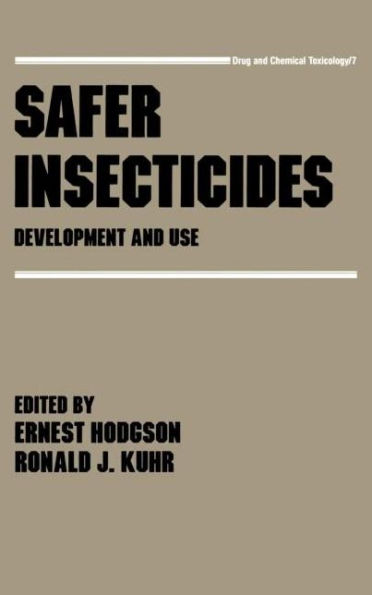Table of Contents
Preface — Contributors — 1. Introduction Ernest Hodgson and Ronald J. Kuhr — I. Introduction — II. Factors Involved in Insecticide Development — III. Approaches to the Development of Safer Insecticides — IV. Summary and Conclusions — 2. Metabolism of Xenobiotics /W. C. Dauterman and Ernest Hodgson — I. Introduction — II. Phase-I Reactions — III. Phase-II Reactions — IV. Nutritional Effects on Xenobiotic Metabolism — V. Physiological Effects on Xenobiotic Metabolism — VI. Genetic Effects on Xenobiotic Metabolism — VII. Chemical Effects on Xenobiotic Metabolism — 3. Quantitative Structure-Activity Relationships of Insecticides Keiichiro Nishimura, Haiime lwamura, and Toshio Fuiita — I. Introduction — II. Quantitative Analysis of Structure-Activity Relationships — III. Approaches Toward Safer Insecticides — IV. Concluding Remarks — 4. Endocrine-Based Insecticides Thomas C. Sparks — I. Introduction — II. Physiological Approaches to Insecticide Selectivity — III. Approaches to Discovering New Insecticides — IV. Exploiting the Insect Endocrine System — V. Endocrine-Based Insecticides: Potential Modes of Action — VI. Conclusions — 5. Nervous-System-Based Insecticides Mohyee E. Eldefrawi and Amira T. Eldefrawi — I. Introduction — II. Voltage-Dependent Ion Channels — III. Neurotransmitter Receptors — IV. Neurotransmitter Synthesis and Release — V. Termination of Neurotransmitter Action — VI. Concluding Remarks — 6. Insecticides Based on Differences in Metabolic Pathways Richard T. Mayer, G. Cunningham, and J. Gupton — I. Introduction — II. Chitin Synthesis Inhibitors — III. Prostaglandins — IV. Steroid Analogs as Insect Molting Hormone Inhibitors — V. Conclusions — 7. Inducers of Plant Resistance to Insects Daniel C. Fischer, Marcos Kogan, and Patrick Greany — I. Introduction — II. Inducers of Plant Resistance or Susceptibility Against Insects — III. Induction of Resistance by Growth Regulators, Plant Hormones, and Herbicides — IV. Induction of Resistance by Previous Herbivory — V. Potential Uses of Induced Resistance in Pest Management — VI. Induced Resistance and Pest Management — 8. Proinsecticides: Metabolically Activated Toxicants Glenn D. Prestwich — I. Fundamental Prodrug Concepts — II. Proinsecticides as Prodrugs — III. A Compendium of Proinsecticides — IV. Future Design Strategies — 9. Natural Products from Plants for the Control of Insect Pests /E. Arthur Bell, Linda E. Fellows, and — Monique S. J, Simmonds — I. Introduction — II. Plant-Based Insecticides — III. The Search for New Products — IV. Toxins vs. Deterrents — V. Insect Perception of Secondary Compounds — VI. Plant Variability and Resistance to Insect Predation — VII. Acquired Tolerance of Antiinsect Compounds in Specialist Feeders — VIII. Conclusions — 10. Viruses and Bacteria as Sources of Insecticides /C. Y. Kawanishi and C. A. Held — I. Introduction — II. Microbial Properties that Affect Pesticidal Use — III. Viruses — IV. Bacteria — V. Biotechnology and the Future of Microbial Pesticides — VI. Conclusions — 11. Spider Toxins as Lead Structures for Novel Pesticides Donald L. J. Quicke and Peter N. R. Usherwood — I. Introduction — II. Spider Taxonomy, Biology, and Toxinology — III. Isolation and Chemical Characterization of Araneid Venoms — IV. Neurophysiological Effects of Araneid — Spider Venoms — V. Conclusions — 12. An Integrated Approach for Improvements in Application Technology Franklin R. Hall — I. Introduction — II. Exposure Potentials with the Use of Agrichemicals — III. Trends and Developments in Application Technology — IV. Physics of Application — V. Biological Requirements — VI. Crop Protection Technology — VII. Prospectus — VIII. Future Needs — IX. Conclusions — 13. Improved Safety Through Reduction in Use of Existing Chemicals /A. M. Agnello and J. R. Bradley, Jr. — I. Introduction — II. Pesticide Reduction as a Result of New Approaches — III. Pesticide Reduction as a Result of New Chemistry — IV. Summary — 14. Safety Considerations Relating to the Manufacture of Agrichemicals in the U.S. and the Third World Gustave /K. Kohn and Stephen J. Raab — I. Introduction — II. The Decision to Manufacture — III. Cost-Benefit Analysis — IV. Analytical Equipment and Its Upkeep — V. Alternatives for Methyl Isocyanate and Phosgene — VI. Chemical Aspects of Risk Reduction for the Manufacture of Carbamates (Urethanes) — VII. Summary — 15. Challenges: The Industrial Viewpoint /J. F. Engel, W. N. Harnish, and C. A. Staetz — I. Introduction — II. Market Considerations — III. Industry Approaches — IV. Constraints — V. The Future — Index.



